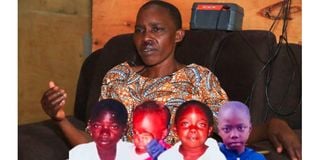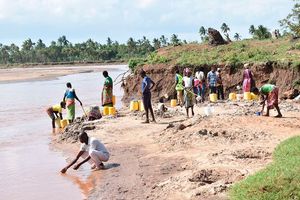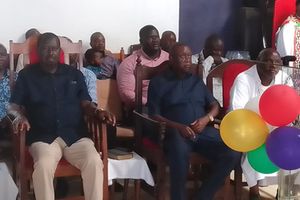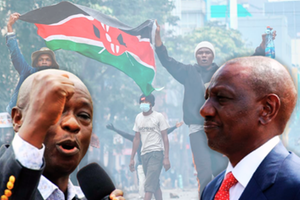Rare genetic disorder that killed my four children

Nelly Achieng with her children (all deceased).
What you need to know:
- Duchenne Muscular Dystrophy is a rare muscle disorder that children inherit from their parents. The genetic condition leads to weakening and wasting away of body muscles.
- It results from a defective gene that results in absence of dystrophin, a protein that helps to keep the body muscle cells intact. Dr Otieno says the disorder inheritance is X-linked so that girls are born carriers while the males are the ones directly affected.
The silence in Nelly Achieng’s house in Rabuor, Kisumu, presses down on her like the weight of the countless tears she has shed. Each empty room echoes with the laughter that once filled them, each floorboard creaked with the phantom memories of the feet of her children. Four names, four faces, four children — stolen by an insidious, mysterious illness that left only her youngest, Wayne Odhiambo, clinging precariously to life.
Nelly moves through the days like a ghost, her smile a faded photograph from a happier time. The ache in her chest is a constant companion, a dull throb that flares into searing agony at the sight of a child’s swing set swaying in the breeze, a forgotten toy gathering dust in a corner. Each sunrise is a reminder of another day without their joyful chaos, each sunset a descent into a darkness punctuated only by Wayne’s fragile breaths.

Nelly Achieng during the interview at her home in Rabuor, Kisumu. She lost four children to a genetic disorder characterised by progressive muscle degeneration and weakness.
Sleep offers no solace. Dreams were battlefields where she fought to hold onto her children, waking with the taste of despair in her mouth and the warmth of their tiny hands slipping from her grasp. The memories, once treasures, now feel like shards of glass, lacerating her with each recollection. Birthdays uncelebrated, milestones unattained, futures extinguished — that weight on Nelly has come with a crushing force.
The walls in her house tell everything: only the portrait of Wayne hangs there, with a smile that struggles to conceal Nelly’s deep sorrow. “I have struggled as a mother, taking care of my children has not been easy. If I was to choose, I would have wanted to die after burying my children, with that I would rest in peace knowing I had left a burden to no one,” Nelly’s heavy-hitting words strike our ears.

Nelly Achieng with her children (all deceased).
When Healthy Nation settles down in her four-roomed tin-roofed house, she pauses amidst the pleasantries, breaks down in between half sentences, a sign that the interview ahead is going to require more than patience.
But the 54-year-old believes that she needs to tell the story of Duchenne Muscular Dystrophy (DMD), a rare yet inherited disorder of progressive muscular weakness.
Nelly’s fourth child succumbed to this disease only a week to his 19th birthday.
Nelly walks to Wayne’s bedroom and carries him to a seat in the living room in readiness for the interview.
She explains that the 13-year-old has already lost his ability to move, thanks to the weakened muscles ; and he has to be helped around when not in a wheelchair.

Phillip Otieno, Nelly’s fourth born who also succumbed to Duchenne Muscular Dystrophy.
For the other four children, she only has a couple of photographs she took with them while still alive, the memories she says are what keeps her going.
When she first conceived back in 1988, Nelly was still in high school. A couple of months later, she gave birth to a bouncing baby boy. She later got married in 1992 after clearing her secondary school education. Her son would then be enrolled in school at her husband’s home in Oyugis, Homa Bay County. A year later, Nelly conceived her second born.
When her first born was in Class Three, Nelly realised he was walking on his toe tips. The nine-year-old could not stand without support. On most occasions, he was always nursing injuries he had sustained after falling down due to loss of stability.
Nelly had however ignored the signs but got worried when her second born son, who was aged three by then, started displaying similar signs.
“I took the two boys to a health facility in Homa Bay but was referred to the Jaramogi Oginga Odinga Teaching and Referral Hospital (JOOTRH) for a medical test,” says Nelly.
At the facility, the two tested negative for malaria. Nelly was offered outpatient services and instructed to visit the facility later in the week to see a paediatrician.
During her second visit, then hospital superintendent Dr Juliana Atieno after performing a number of tests informed Nelly her sons had DMD.

Nelly Achieng assists her only surviving son, Wayne Odhiambo, 13, onto a wheelchair at their home in Rabuor, Kisumu. Wayne is suffering from Duchenne Muscular Dystrophy.
She would later explain that the condition, a rare genetic disorder mainly affecting male children, could not be reversed. Nelly was advised to visit the facility with her spouse but this never happened since her husband was still in denial.
“One of my most painful memories was when the doctor informed me that the condition had no cure, my children would only survive on physiotherapy, which did not help much, and the result would be untimely death ,” Nelly recalls.
This was the beginning of her painful journey, bringing up the physically disabled boys while the muscular disorder kept progressing.
Back at home, she made up her mind to leave the village in search of a job having graduated as an ECD (Early Childhood Development) teacher.
Her change of location had been inspired by the growing stigma at home, where everyone thought that she had been cursed.
The village was also hilly, making movement for her sons, who had lost their ability to walk a few years after diagnosis, impossible.
She notes that some of her in-laws on the other hand were convinced that she had been cursed and would never be able to conceive a healthy child . “The only solution was for my husband to remarry,” she says while fighting back tears.
In Kisumu, she was lucky enough to get a job at one of the private schools while her sons were enrolled at a special school.
She had conceived her third born a few months after relocation while hoping that this time it would be a baby girl.
Meanwhile, she would religiously take the two boys for physiotherapy sessions two times every week, a practice that saw her part with Sh16,000 per month.
The responsibility of taking care of the boys had been solely left to the ECD teacher, whose meagre earnings could hardly sustain the family.
But she was determined to give the boys a comfortable life, when forced to. Nelly took out a loan to buy a wheelchair.
Nine months later she gave birth to a baby boy. Just like his older brothers, he had been healthy, attended all the early childhood vaccinations and even got enrolled in school.
At the age of three, he was also struggling to walk and getting up while seated. Most of his friends would make fun of him and his mother had to facilitate his transfer.
A few months later, he was already using a walker to move around. “What I did not understand is why I would attend all my antenatal clinics, give birth to healthy boys who were all vaccinated but at the age of three, they would start experiencing similar challenges,” says a teary Nelly.
But despite all this, she had conceived yet again and given birth to another boy. Back at home, the third born had also completely lost his ability to move.
The first two boys on the other hand had dropped out of school since their hands had grown weak and could no longer write. They could also not feed on their own while their meal consisted of soft foods.
But Nelly had to take care of all the four children alone, including the newborn who was only a few months old.
In the year 2009, she had visited a health facility feeling unwell only for the doctors to confirm that she was pregnant.
This time Nelly had sworn that this was her last attempt — if the baby ended up being a boy, she was never trying for another baby again.
In 2010, her first born son was rushed to the hospital after developing breathing difficulties’. A few hours later, he was confirmed dead. The doctor attending to him informed the family he had died from an enlarged heart. He died at the age of 20.
His body would then be transported back to Oyugis, where he was laid to rest. When she travelled back to Kisumu, Nelly gave birth to her last born son.
Two years later, her second born son succumbed to an ulcer complication. “In 2014, my third born son was also rushed to a health facility after developing breathing complications but died a day later, the doctors said he had severe pneumonia,” Nelly explains.
The second last born boy was enrolled in school while her last born son had also started experiencing difficulties in walking.
Her fourth son had been smart in school, he was always top of his class but his studies were cut short at Standard Seven when his muscles grew weaker and he could not move around comfortably in his wheelchair.
He had, however, come across a sponsor who got him a phone which kept him busy. He was always researching, connecting with friends or playing games.
On June 22, 2023, the 18-year-old breathed his last after he was rushed to Rabuor Sub-county Hospital. The post mortem results revealed that he had died of severe pneumonia.
Dr Walter Otieno, a paediatrician at JOOTRH, describes DMD as a rare muscle disorder that children inherit from their parents.
The rare genetic condition leads to weakening and wasting away of body muscles. The disorder results from a defective gene that results in absence of dystrophin, a protein that helps to keep the body muscle cells intact. Dr Otieno says the disorder inheritance is X-linked so that girls are born carriers while the males are the ones directly affected.
The children in this case are always born healthy but start displaying the symptoms when they are between three to six years.
The early signs include the child growing weaker, while the calf muscles (muscle at the back of the lower leg) become larger as the child grows.
As they grow, the baby will be a little slow when walking, with time they easily fall down and cannot climb stairs. By this time, the tender achilles, the point where calf muscles intersect into the feet, become tight while the knees start to bend backwards.
“Eventually in time, the child will start experiencing weakness of the hips and back of the legs. The back of the toddler will be arched while the abdomen bulges out,” says the Maseno University lecturer of medicine.
According to the health expert, the weakness the child is subjected to is progressive, starts from the lower limbs to the upper limbs, and with time it moves to the muscles of the abdomen.
In the initial stages, the child in question can use a walker but with time, they will eventually need a wheelchair to move around.
In most times, when the affected child clocks their teen, the muscle of their chest cage becomes weak, interfering with their breathing.
“The teenager will start getting weak with recurrent chest infections, which makes them highly dependent on oxygen. Sometimes we perform nebulisation to remove the secretions from their chest,” says the paediatrician, adding that respiratory and heart failure are the leading causes of deaths among those living with the disorder.
While a number of remedies have been tried to manage the disorder including use of steroids, the health expert says none of them is yet to provide a permanent solution.
At the moment, the available management is physiotherapy sessions. The parent or caregiver also needs to attend to the needs of the child including getting them a wheel chair to aid in movement.
The health expert also recommends nebulisation to ease chest congestion and provision of oxygen supply whenever need be. Regular cancelling and social support for both child and parents is crucial.
The health expert further says that the earlier a child with the disorder starts their physiotherapy session the better.
Dr Otieno was among the health experts who attended to some of the deceased children of Nelly and says the disorder cases are very rare. “Nelly’s children were the third case that I came across. The first time I attended to a child with the disorder was more than 20 years ago” says the doctor.
The rare condition affects one in 3,500 newborn males. In Kenya, however, diagnosis is often delayed.
In 1986, the Muscular Dystrophy Association supported researchers identified a particular gene on the X chromosome that when mutated leads to DMD. The protein associated with the gene was identified and named dystrophin. When the muscle cells lack dystrophin, protein, they become fragile and easily damaged. DMD has an X-linked recessive inheritance pattern and is passed on by the mother who in this case is the carrier.
Initially, boys with the condition would not live past their teens, but due to the advancement in cardiac and respiratory care, survival into their early 30’s has now become common.
As we wind up our interview, the sun dips below the horizon, casting long shadows across Nelly’s garden. She steps outside, so do we. The air is cool, but she doesn’t feel the chill. She looks up at the star-strewn sky, each twinkle a tiny reflection of the love she holds in her heart. A single tear rolls down her cheek, but this time, it is not a tear of sorrow, but a tear of hope. The grief may never leave her, but neither will the love. And in that bitter-sweet dance between loss and love, Nelly finds the strength to walk on, carrying the light of her children within her, forever etched in her soul.





